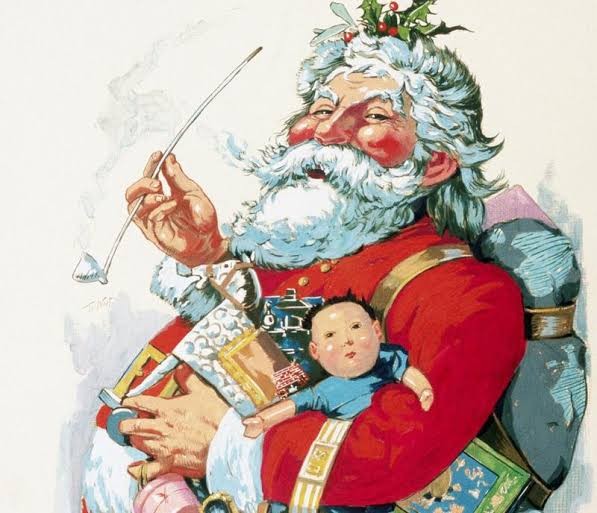I got curious and started doing some research on Saint Nicholas, whick lead me to Saint Nick, which of course led me to Santa Claus.
In a nutshell, each is woven to the other. According to the St. Nicholas Center, here are some quick facts to help with any confusion.
- Nicholas, who was born during the third century in the village of Patara in Asia Minor. At the time the area was Greek and is now on the southern coast of Turkey. His wealthy parents, who raised him to be a devout Christian, died in an epidemic while Nicholas was still young. Obeying Jesus’ words to “sell what you own and give the money to the poor,” Nicholas used his whole inheritance to assist the needy, the sick, and the suffering. He dedicated his life to serving God and was made Bishop of Myra while still a young man.
- Bishop Nicholas suffered for his faith, was exiled and imprisoned. The prisons were so full of bishops, priests, and deacons, there was no room for the real criminals—murderers, thieves and robbers.
- The anniversary of his death became a day of celebration, St. Nicholas Day, December 6th (December 19 on the Julian Calendar)
- A story of Bishop Nicholas tells of a poor man with three daughters. In those days a young woman’s father had to offer prospective husbands something of value—a dowry. The larger the dowry, the better the chance that a young woman would find a good husband. Without a dowry, a woman was unlikely to marry. This poor man’s daughters, without dowries, were therefore destined to be sold into slavery. Mysteriously, on three different occasions, a bag of gold appeared in their home-providing the needed dowries. The bags of gold, tossed through an open window, are said to have landed in stockings or shoes left before the fire to dry. This led to the custom of children hanging stockings or putting out shoes, eagerly awaiting gifts from Saint Nicholas. Sometimes the story is told with gold balls instead of bags of gold. That is why three gold balls, sometimes represented as oranges, are one of the symbols for St. Nicholas. And so St. Nicholas is a gift-giver.
- Through the centuries St. Nicholas has continued to be venerated by Catholics and Orthodox and honored by Protestants. By his example of generosity to those in need, especially children, St. Nicholas continues to be a model for the compassionate life.
- The first Europeans to arrive in the New World brought St. Nicholas. Vikings dedicated their cathedral to him in Greenland. On his first voyage, Columbus named a Haitian port for St. Nicholas on December 6, 1492. In Florida, Spaniards named an early settlement St. Nicholas Ferry, now known as Jacksonville.
- In 1773 New York non-Dutch patriots formed the Sons of St. Nicholas 1, primarily as a non-British symbol to counter the English St. George societies, rather than to honor St. Nicholas. This society was similar to the Sons of St. Tammany in Philadelphia. Not exactly St. Nicholas, the children’s gift-giver.
- After the American Revolution, New Yorkers remembered with pride their colony’s nearly-forgotten Dutch roots. John Pintard, the influential patriot and antiquarian who founded the New York Historical Society in 1804, promoted St. Nicholas as patron saint of both society and city.
- January 1809, Washington Irving joined the society and on St. Nicholas Day that same year, he published the satirical fiction, Knickerbocker’s History of New York, with numerous references to a jolly St. Nicholas character. This was not the saintly bishop, rather an elfin Dutch burgher with a clay pipe.
- Christmas of old was not the images we imagine of families gathered cozily around hearth and tree exchanging pretty gifts and singing carols while smiling benevolently at children. Rather, it was characterized by raucous, drunken mobs roaming streets, damaging property, threatening and frightening the upper classes.
- Through the first half of the 19th century, Presbyterians, Baptists, Quakers and other Protestants continued to regard December 25th as a day without religious significance, a day for normal business.
- 1821 brought some new elements with publication of the first lithographed book in America, the Children’s Friend. This “Sante Claus” arrived from the North in a sleigh with a flying reindeer. The anonymous poem and illustrations proved pivotal in shifting imagery away from a saintly bishop. Sante Claus fit a didactic mode, rewarding good behavior and punishing bad, leaving a “long, black birchen rod … directs a Parent’s hand to use when virtue’s path his sons refuse.” Gifts were safe toys, “pretty doll … peg-top, or a ball; no crackers, cannons, squibs, or rockets to blow their eyes up, or their pockets. No drums to stun their Mother’s ear, nor swords to make their sisters fear; but pretty books to store their mind with knowledge of each various kind.”
- The jolly elf image received another big boost in 1823, from a poem destined to become immensely popular, “A Visit from St. Nicholas,” now better known as “The Night Before Christmas.”
- The New York elite succeeded in domesticating Christmas through a new “Santa Claus” tradition invented by Washington Irving, John Pintard and Clement Clarke Moore
- In 1863, during the Civil War, political cartoonist Thomas Nast began a series of annual black-and-white drawings in Harper’s Weekly, based on the descriptions found in the poem and Washington Irving’s work. These drawings established a rotund Santa with flowing beard, fur garments, and an omnipresent clay pipe.
- Churches, influenced by German immigrants who loved Christmas, Clement Clarke Moore, Washington Irving, Charles Dickens, the Oxford Movement in the Anglican church, and church musicians embracing carol singing, began to bring Christmas observances into their lives. The growth of Sunday Schools in cities exposed hundreds of thousands of children to Christianity. Initially opposed to Christmas observance, by the 1850s Sunday Schools had discovered that a Christmas tree, Santa and gifts, greatly improved attendance. So, in a strange twist of fate, the new “secular” Santa Claus, no longer seen as a religious figure, helped return Christmas observance to churches.
- Santa was then portrayed by dozens of artists in a wide variety of styles, sizes, and colors. However by the end of the 1920s, a standard American Santa—life-sized in a red, fur-trimmed suit—had emerged from the work of N. C. Wyeth, J. C. Leyendecker, Norman Rockwell and other popular illustrators. The image was solidified before Haddon Sundblom, in 1931, began thirty-five years of Coca-Cola Santa advertisements that further popularized and firmly established this Santa as an icon of contemporary commercial culture.





